University Alumni Magazines

Written by Matt Berringer
December 14, 2020
Upon graduation, many alumni want to remain aware of the news from their school. However, many universities miss out on engaging alumni properly. In fact, 85% of alumni feel their school does not do enough to draw younger graduates into continuing support of the university. They want to see more benefits for alumni and more ways to engage in the information. One way to bring graduates the news they desire while offering beneficial information is through publishing a university alumni magazine.
Through a magazine, readers can stay connected to the school by reading articles about the university or getting professional tips. This news source can also be a place to inform graduates about an alumni fundraising campaign or promote other ways graduates can give back to their school. Engaging with alumni through a magazine or newsletter offers readers the news and information they crave while sharing ways for them to give back to the university.
Find out more about:
- Alumni Engagement 101
- Persona Mapping and Personalized Alumni Engagement Content Creation
- Choosing a Medium That Works
- Identifying Relevant Alumni Content
- Promoting Your Content and Reaching Alumni
- Monitor Engagement and Improve Campaigns
- Choose a Platform That Works
Alumni Engagement 101
Whether you want to find out how you can raise money for alumni or how you can successfully start a corporate alumni program, the answer always starts with alumni engagement. Having resources for alumni keeps them connected to each other and the university. When they feel they are a part of the school’s family even long after graduation, they may be more inclined to offer assistance to alumni fundraising campaigns and other calls to help their school.

1. What Is Alumni Engagement?
Alumni engagement definitions vary based on the institution. Before working on a magazine or other outreach program, you must have a definite goal for what you want to do with the content. How you define engagement will direct and drive your content creation and marketing. Since engagement ideally creates a group of alumni who feel more connected, attracted and influential in their school, consider making this your aim.
2. How Do I Connect With My Alumni?
Connecting with alumni requires that you first understand your audience. Many schools have alumni from a wide range of generations. In fact, depending on your school, you may have people from the baby-boom generation through the latest Generation Z members. You may not be able to use the same strategy to reach everyone.
For instance, offering both a print and digital version of your magazine can reach a wider range of generations than using one format. Or, you could use digital formats that replicate a traditional magazine, like nxtbook4, or more interactive digital media, like PageRaft. By offering digital media, you can deliver the information directly to younger alumni via their mobile devices. For older graduates, mailed magazines offer a way to connect at home or work.
Just as you must know the audience and offer media that meets their needs, you will also need to have content to appeal to all ages and professional levels, from new graduates to seasoned experts. The right content could produce successful outcomes, such as having readers recommend others attend the university or make a donation to the school. Of alumni magazine readers, 32% recommended the university and 38% made donations.
3. How Can I Increase My Alumni Engagement?
Having around one-third of graduates telling others about the school or making a donation is a success, but you may want to increase the engagement of your alumni readers. You should offer benefits to your alumni for their engagement. Can they learn about job opportunities or networking through an alumni organization? Do they need the latest trends from their industry published in an alumni magazine? What about more information on how they can engage in the school? Publishing the right content that gives your alumni a return on their investment in the school can improve their engagement.
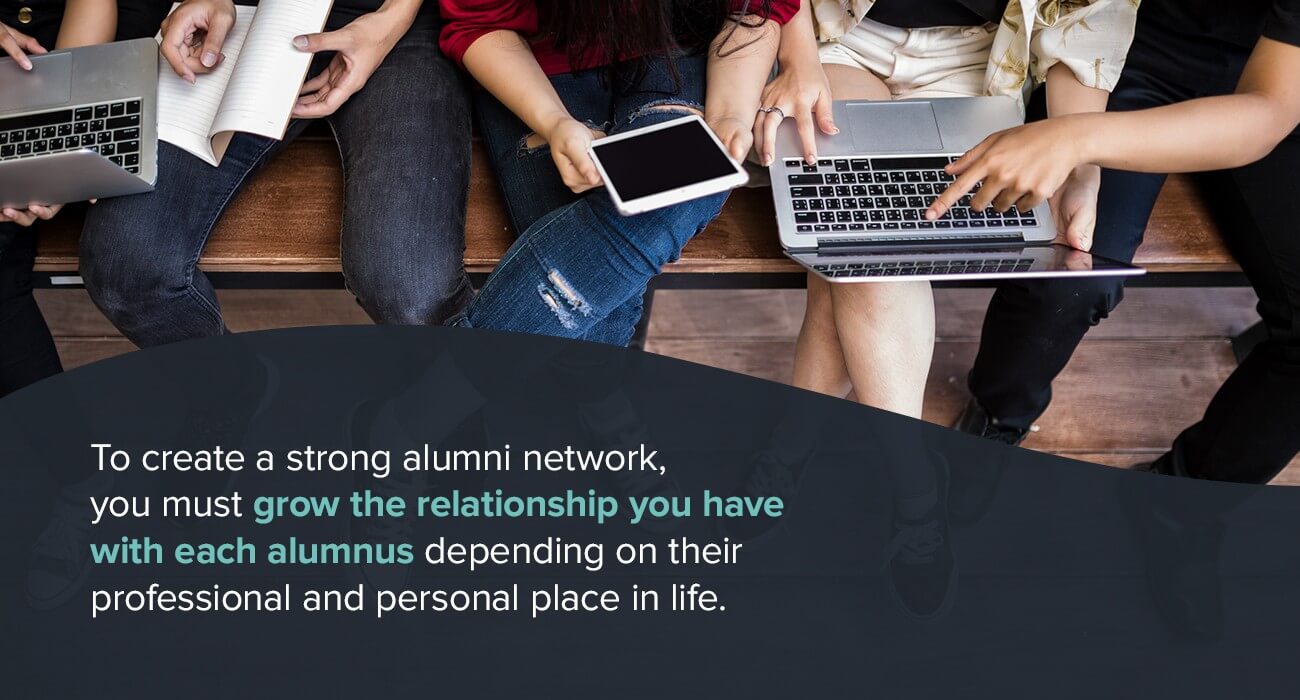
4. Why Is It Important? And How Do You Make a Strong Alumni Network?
Having a strong alumni network increases the connectedness former graduates have with your school and with each other. Additionally, when you have alumni interacting with the magazine and school, you may experience increased donations.
To create a strong alumni network, you must grow the relationship you have with each alumnus depending on their professional and personal place in life. For instance, you cannot expect recent graduates to leave a legacy to the school because they must establish their careers and pay off student loans. After years of working with alumni and encouraging giving, volunteering and interacting with the school, you may hope to have an alumnus leave a legacy in the form of a scholarship or fund to the school.
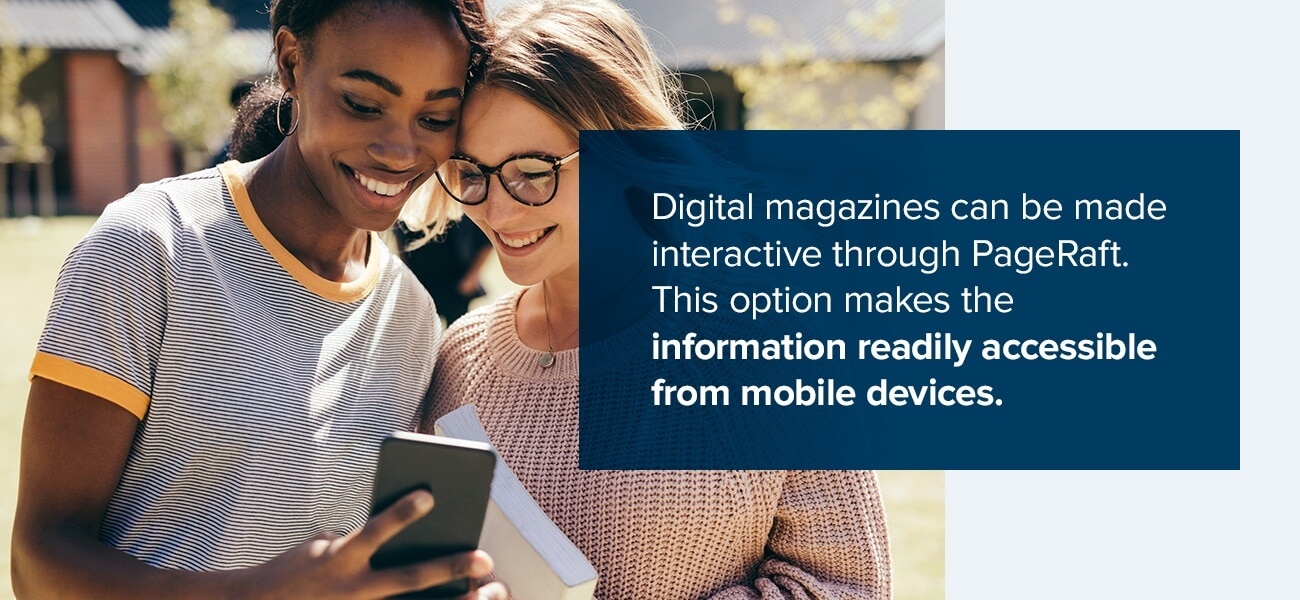
5. Why Focus on Digital Content for Alumni Engagement?
In a survey of institutions with alumni magazines, 87% offered both a digital and print copy of their periodical. This method is only one way to address the concern of 75% of alumni who find alumni organization technology solutions to be lacking. Only offering a simple replication of a print magazine may not attract younger users who want interaction and access via mobile devices on social media and through other methods.
Digital content offers several benefits over print media. First, digital magazines can be made interactive through PageRaft. This option makes the information readily accessible from mobile devices. You can also make it easily sharable via social media or regulate who can see the information through controlling the digital rights, allowing only alumni the benefit of the data in your magazine. You can even have direct links to donation pages on your site to facilitate fundraising efforts.
By choosing digital content, alumni don’t have to check their mail to see information from their alma mater. They can open an email or check social media for the alumni magazine and all its content.
6. Information Gathering: What Do Alumni Want?
When it comes to connecting with alumni, you need to find out what they want. Gathering information can include data on demographics, professions and interests of school graduates. Use this information to guide the topics of articles and content in your alumni magazine.
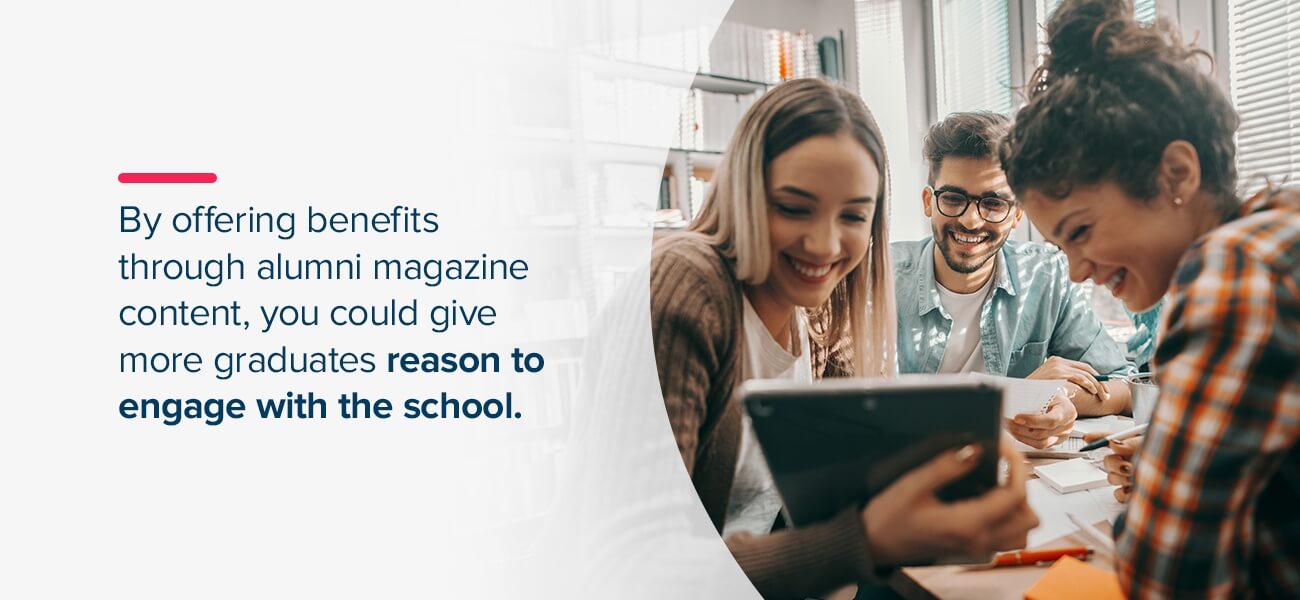
7. What We Know About How to Engage Alumni
We know that schools struggle with alumni engagement. About 90% of institutions that do not offer benefits don’t have engaged alumni. A majority of 67% report the erroneous belief that alumni only need to have a reminder of their sense of duty or philanthropy to donate to the school. This notion correlates to high alumni opt-out rates for those who do not want to receive future communications. Alumni who opt out may feel there is no benefit to getting information. By offering benefits through alumni magazine content, you could give more graduates reason to engage with the school.
8. Surveying Alumni
Send out alumni surveys to find out what they want in a magazine. By catering to their needs and desires, you can take steps toward offering the benefits they want. When you use alumni feedback to guide the content in your alumni magazine and credit them with ideas, they may feel more involved in the school and alumni organization. For instance, you could request success stories from alumni and get permission to publish them in the magazine.
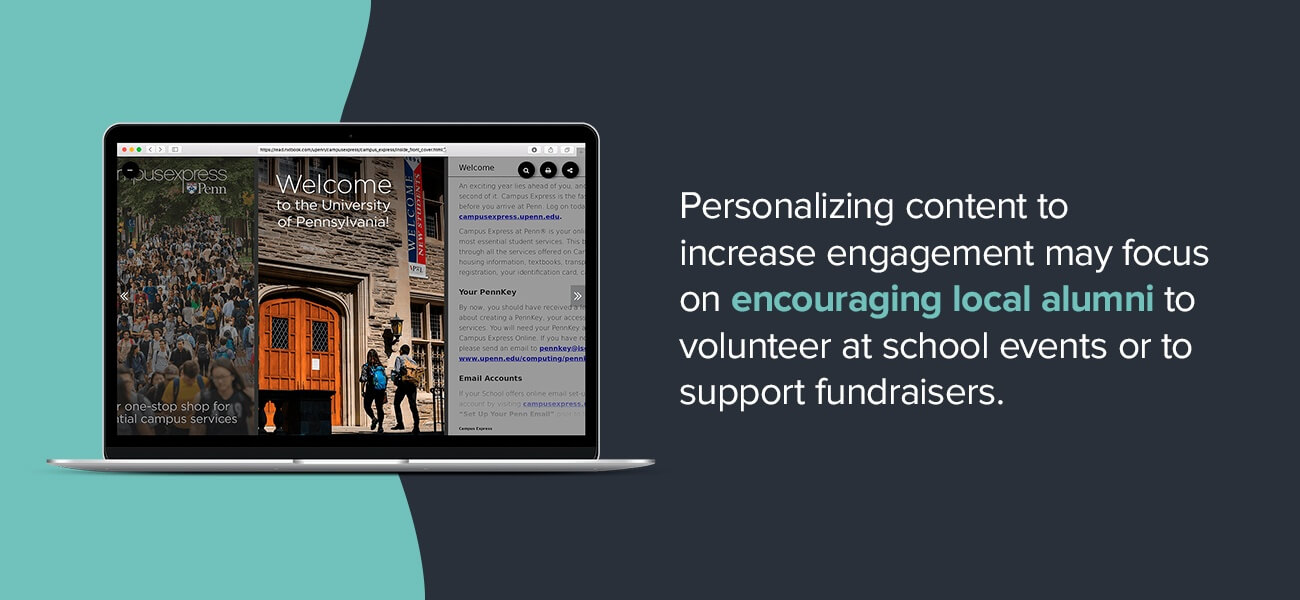
Persona Mapping and Personalized Alumni Engagement Content Creation
Using the information you collect from surveys, you can personalize content to individuals or groups. Persona mapping targets specific groups. You could have an issue of the magazine aimed at the class of 2000 based on the information the survey respondents from that class gave in the graduate survey. Though persona mapping for various groups will take time, you will have more targeted information that resonates more with alumni than generalized information.
Personalizing content to increase engagement may focus on encouraging local alumni to volunteer at school events or to support fundraisers. Encourage those who live away from the school to subscribe to the alumni organization newsletter or to sign up for a private social media group. These means of engagement get the graduates talking to school representatives from the alumni organization and to each other.
Another means of personalizing content is through staying abreast of topics that matter most to alumni. Changes in demographics may require amending content to meet the needs of those shifts. If more alumni in recent years come from out of state, you likely don’t want to focus your magazine content exclusively on events local to the school.
Choosing a Medium That Works
The first decision in choosing a publication for your alumni is the media. Magazines and newsletters each have benefits to their readers and to you. You may even consider both, with magazines for general alumni news and newsletters for personalized stories. Whichever media you choose, the most important element will be the content you have in it.

Magazines
Magazines published by institutions are produced by an average of one or two staff members, are distributed up to three times a year and use both staff and freelance writers for creating content. You may want to go beyond average to get the most from your magazine. First, consider a digital version of your magazine. You can make it more interactive with PageRaft or more traditional with nxtbook4. In either case, make it look great with professional-quality photos, a clean and straightforward layout and content or ideas from alumni.
Magazines are a longer form of media compared to newsletters. You can have longer articles such as alumni success stories, tips for professionals, industry news, guides for post-graduation life and career, and training information. These types of posts benefit alumni with value-adding content instead of fluff that only outlines the latest campus events.
If you use freelance writers, consider recruiting alumni for some articles. Don’t forget to indicate them as alumni. If you get article ideas from graduates in surveys, credit the person by name and class to encourage future participation from others. Your magazine should be a product of the relationship you have with alumni, and they need to see they have an influence on the content to feel more valued.
Newsletters
When creating a newsletter, the length won’t be as long as a magazine. You may want to publish these more frequently than magazines. The shorter length makes the content that you have even more important. Don’t overwhelm the reader with walls of text. Break up stories by only focusing on important information someone can read quickly.
Aim to include interesting articles that focus on information readers can use. For instance, write how-to, entertainment and professional articles instead of covering solely institution news. For digital newsletters, make the most of links to allow readers to quickly access important alumni links to professional groups, local discounts, social media and surveys for your alumni organization.
Try to make your newsletters visually interesting. The reader will likely see the images and headlines first, so the pictures and titles you choose need to be eye-catching and encourage people to read the stories. Lastly, optimize the layout of the newsletter for viewing on both mobile devices and desktop computers instead of printed on a page. Doing so can ensure your readers will get the best experience possible from the digital newsletter.
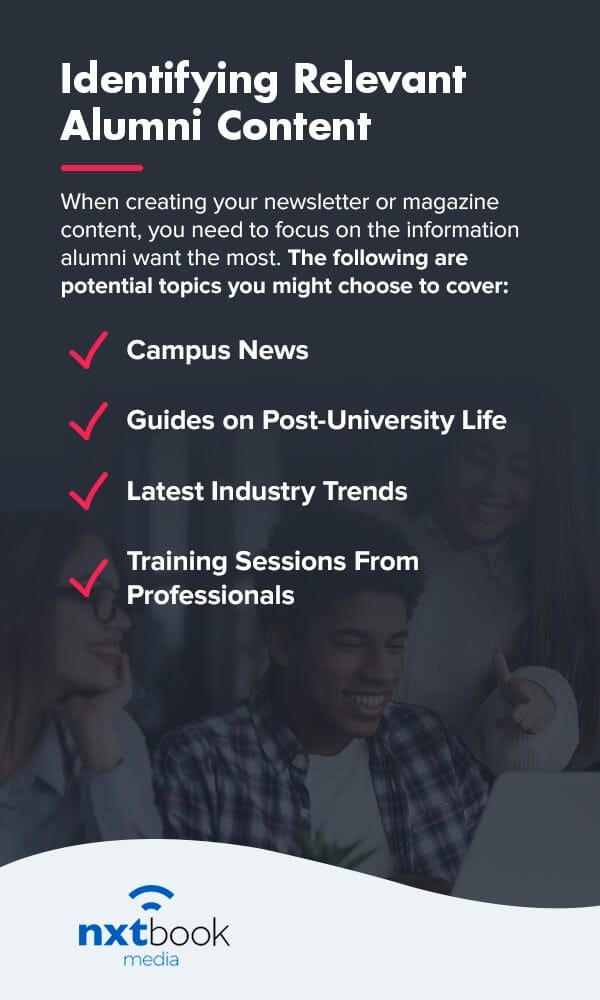
Identifying Relevant Alumni Content
When creating your newsletter or magazine content, you need to focus on the information alumni want the most. Though your goal may be to solicit donations, this topic ranks at the bottom of the list of newsletter content alumni have the most interest in. The top of the list includes campus news, alumni events, class notes, discounts and networking. While you can have donation and survey requests, do not make them the focus of your content.
The following are potential topics you might choose to cover:
1. Campus News
Campus news should include things alumni may find interesting. Report on student successes in the university’s programs. If you have a persona mapping of music students, you may want the campus news section to have information about music competitions or performances. For former athletes, you may include more sports stories. For science majors, give information about current research students and faculty are working on.
By sharing campus news that focuses on specific groups, you can make more personalized content that readers may have a greater interest in.
2. Guides on Post-University Life
As noted, one of the problems with alumni engagement is getting younger graduates interested in alumni organizations. Offering stories on post-university life such as starting a career, how to network and job postings can bring this hard-to-engage group into the sector that contributes to the school.
3. Latest Industry Trends
Industry trends will tend to focus on the department you write for. This is another way to personalize newsletters or magazines based on persona mapping results. You can have newsletters for the school of engineering, for instance, that have news about that field and alumni in it.
4. Training Sessions From Professionals
If alumni from your school or the university offer extra classes or training sessions for graduates, let alumni know about these opportunities. Like alumni discounts, training sessions and similar education opportunities can help alumni to feel valued and like they are getting quality benefits in return for graduating from the school or for donating.
Promoting Your Content and Reaching Alumni
To get alumni to read your magazine or newsletter, you first have to tell them about it. Even if they automatically receive copies, they will likely still need reminders of all the great content you put into the media. Accordingly, it may be helpful to promote your content and find new ways to reach out to alumni through social media and email campaigns:
Social Media
Many alumni, especially younger ones, use social media as a method of connecting. This gives you a valuable opportunity to promote your content on social platforms. Make use of groups and your profile pages on multiple social media platforms. Most importantly, take time to show active involvement in posting, both in answering questions and promoting content. Update your profile regularly and follow through whenever someone asks a question or makes a comment.
While constantly updating social media is important, you cannot solely rely on this unpaid method of driving traffic to your content. In fact, unpaid reach on Facebook is 5.5%, which likely will not encourage high interactivity with your alumni magazine or newsletter. You can invest in paid ads on social sites to increase your exposure and improve interactivity rates.
Email Campaigns
Email campaigns are another crucial aspect of reaching alumni. Use an A/B method of promotional emails. Divide a small group in half with lists A and B. Send one version of your email to group A. Give the second group a variation of the email. Look at the open and response rates. Use the version of the email that got the most responses for the message you send to all alumni. This testing method can make your campaigns more effective by finding out the target needs and interests of your audience without sending out surveys.
If you use email to send digital newsletters, create a schedule for publication and stick to it. Sending newsletters late or skipping a delivery can reduce interest in your alumni organization. Be consistent with both newsletter and magazine delivery to maintain high interest and interaction rates with your content.
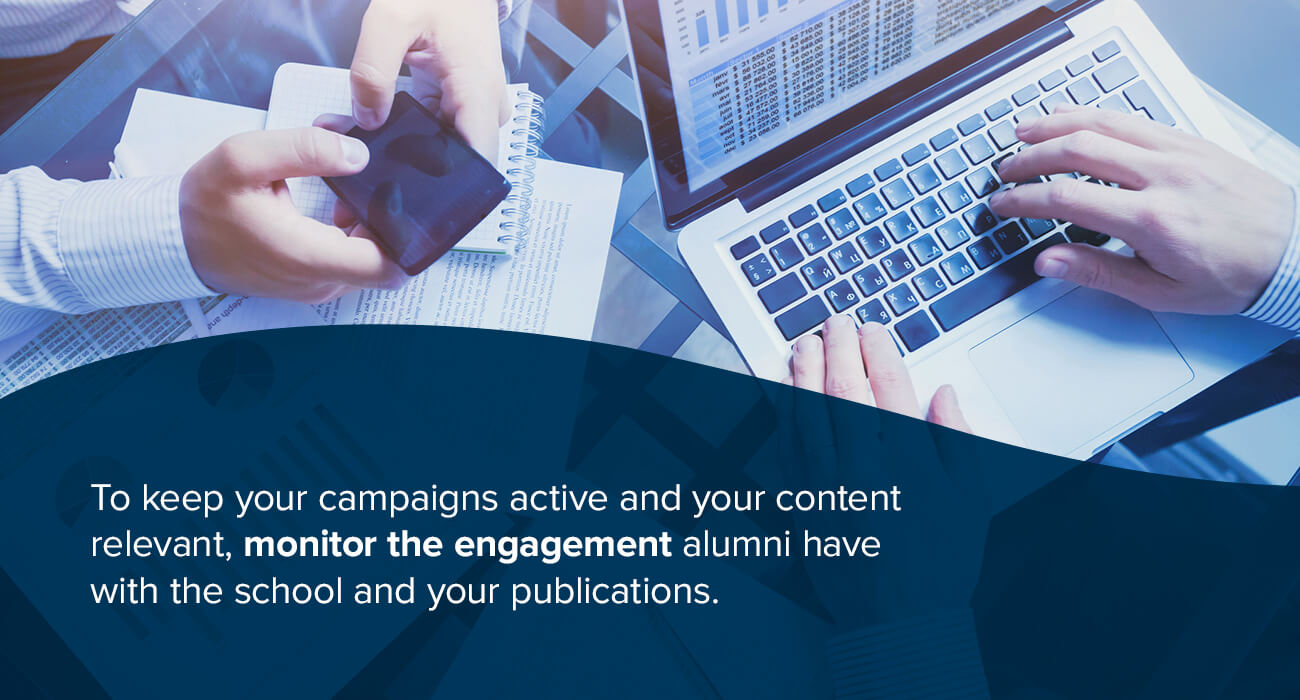
Monitor Engagement and Improve Campaigns
To keep your campaigns active and your content relevant, monitor the engagement alumni have with the school and your publications. Keeping track of these measures can ensure you are effective in reaching out to your institution’s graduates.
Metrics That Matter
The raw number of alumni you send your publication to is a starting metric. To ensure your content resonates with readers, you need to monitor other values, too. For your magazine or newsletter, keep track of key metrics such as the number of visitors and unique visitors, downloads, shares, time engaged, interactions and bounce rates. These measurements tell you how many individuals read your content, how long they spent looking at it, whether they clicked on interactive portions of the site and if they left the page immediately after opening it.
Collecting Data to Improve Your Strategy
When working with Nxtbook Media products, you can generate reports on these vital analytics to facilitate your campaign. By knowing the metrics that matter most, you can be sure the content you create is most effective and identify where you need to make changes. For instance, by knowing what portions of your digital magazine that alumni interact with, you know what content they like. Article shares are also crucial because those pieces are important enough to the readers that they think others will gain value from them.
Pay careful attention to data gathering and analysis to guide your future content. Doing so can help you create informative, interesting articles alumni will want to interact with. By feeling more engaged with content from your institution, they may also feel more connected with the school, eventually meeting your goal of becoming donors or involving themselves in other ways to support the institution.
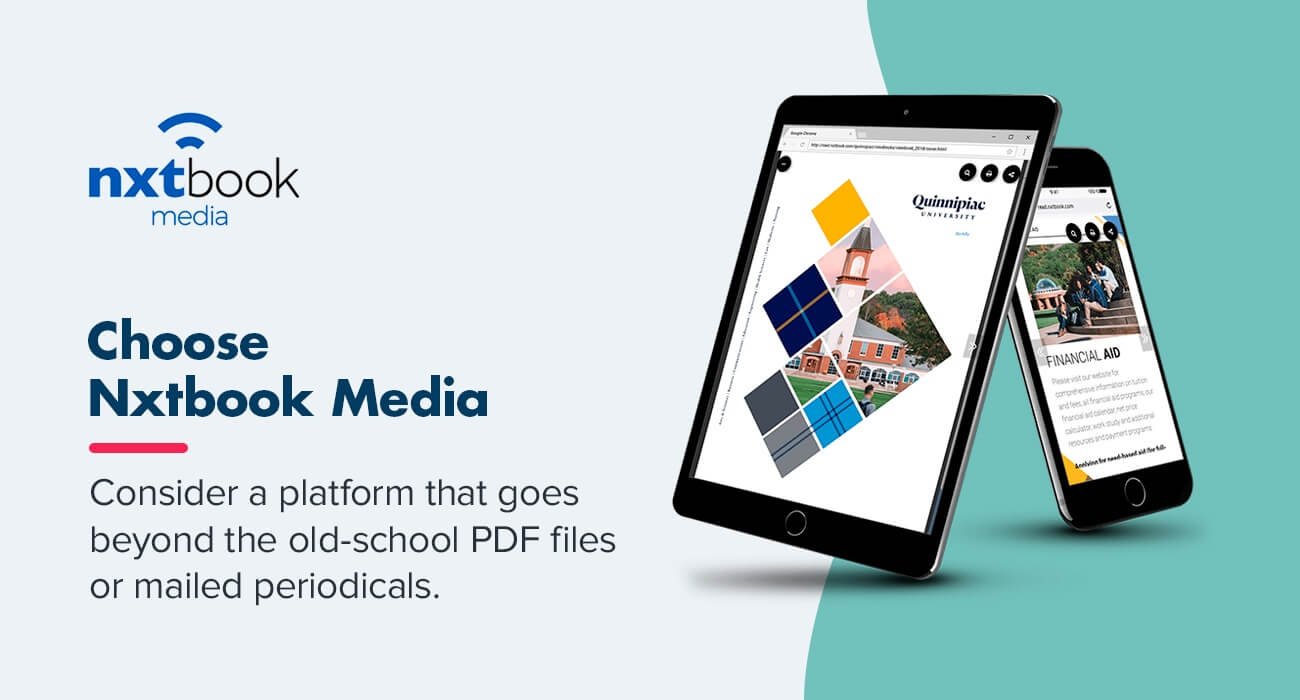
Choose a Platform That Works
When it comes to creating content that engages your alumni, consider a platform that goes beyond the old-school PDF files or mailed periodicals. With Nxtbook Media, you have two platform options, each with its own advantages. Our platforms have empirical evidence backing their effectiveness. For example, most websites average 2 minutes to 3 minutes for a visitor — our digital media has an average visitor time of 7 minutes. When alumni are looking at your content longer, they are more likely to be reading the material in-depth, creating an emotional or mental connection with the information.
Interactive digital media that works across all platforms with PageRaft can bring the magazine experience to mobile devices and more, allowing alumni to engage wherever they are. For a more traditional format, choose nxtbook4, which replicates familiar print layouts. You could even leverage the advantages of both to engage with younger and older alumni.If fundraising or building an alumni program at your school are your ultimate goals, begin with engaging graduates in the school’s current business. One way to do that is through digital university alumni magazines that connect with the needs of alumni and give them a reason to continue to support the school.
To find out more about starting a digital magazine with Nxtbook Media, schedule a demo or call us at 866-268-1219 and choose option six today.
Learn More About Digital Content
How-to Guides
- Develop an Effective Content Marketing Plan
- Building a Content Calendar
- Content Experiences at Scale
- How to Create Responsive Digital Content
- How to Find Content
Strategy & Planning
- How to Leverage Interactive Content
- Using Infographics in Digital Magazines
- Using Storytelling in Your Content Experience
Measuring KPIs & Metrics